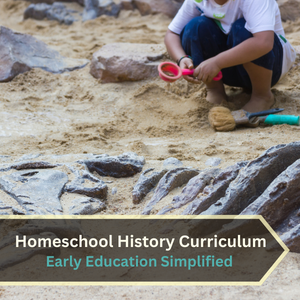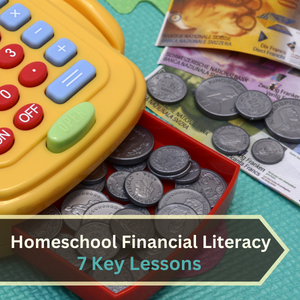Welcome to the world of homeschool history curriculum, dear moms! Have you ever pondered the magic of history and its ability to transport us back in time? As you embark on your homeschool journey, especially with little ones in tow, understanding how to make history not just a subject but a captivating story is key. For our curious learners in early education, homeschool history isn’t just about memorizing dates and facts. It’s about nurturing a deep-rooted fascination with the past and its myriad lessons.
Why History Matters: Let’s face it, history shapes our identity, understanding, and our future. In the tender years of elementary education, homeschool history presents a unique opportunity. It helps children develop a sense of time, place, and cultural understanding, laying a foundation for lifelong learning and curiosity.
Fundamentals of Tailoring History Lessons for Younger Students
Navigating through homeschool history can be like exploring a vast treasure trove. But where do you start? Here are some nuggets of wisdom:
- Simplicity is Key: Start with broad strokes. For younger minds, the grand narratives of history are more absorbing than the nitty-gritty details. Think big pictures and bold characters.
Relatable Content: Choose historical topics and figures that resonate with their everyday life. In your social studies, can they draw parallels between a world-historical event and something they’ve experienced? This connection is a powerful tool in homeschool history.
Examples:
- Simplifying complex events like the American Revolution into fundamental ideas about freedom and change.
- Adjusting the depth of historical content based on the child’s age (more visuals for younger children).
- Presenting history through storytelling, focusing on the narrative rather than dates and details.
Interactive and Engaging Teaching Methods for History
Say goodbye to monotonous lectures in your homeschool curriculum. In homeschool history, it’s all about interaction and engagement. Here are some strategies to keep those young minds enthralled:
- Storytelling: History is essentially a collection of stories. Use vivid storytelling in your homeschool curriculum to make world historical events come alive. Imagine narrating the story of Cleopatra or the Wright Brothers as an exciting bedtime story.
- Role-Playing: Transform your living room into a historical stage. Let your kids dress up as historical figures or act out significant events. This hands-on approach to homeschool history makes learning fun and memorable.
Examples:
- Creating a mock archaeological dig in the backyard to explore ancient civilizations.
- Hosting a medieval fair at home, complete with costumes and themed activities.
- We are using role-play to reenact significant historical events, like the signing of the Declaration of Independence.
Incorporating Visual and Hands-On Learning in Homeschool History Curriculum
We all know that seeing and doing are powerful ways of learning. How can we apply this to homeschool history?
- Time Capsules: Create DIY time capsules with your kids. Fill them with ‘artifacts’ representing different eras. Digging them up months later to recap what they’ve learned can be exhilarating.
- History Through Art: Use art and craft to depict historical events or create timelines. This visual representation of homeschool history helps solidify their understanding creatively.
Examples:
- Building a model of the Roman Colosseum using cardboard and craft materials.
- Creating a timeline on the wall with pictures and drawings of different historical periods.
- Designing a family tree to explain genealogy and historical lineage.
Utilizing Technology and Multimedia Resources
In this digital age, technology is a valuable ally in homeschool history. Here are some ideas:
Educational Apps and Games: Harness the power of educational apps that bring historical periods to life through interactive games and quizzes.
- Virtual Tours: Take advantage of virtual tours of world history museums and historical sites in your homeschool curriculum. This is a fantastic way to boost your homeschool history lessons visually and interactively.
Examples:
- Using apps like Google Earth to explore historical sites virtually.
- Watching age-appropriate documentaries on historical events and figures.
- Incorporating interactive online games that teach historical facts and stories.
Integrating Literature and Historical Fiction in the Curriculum
When it comes to homeschool history, books are your best friends. Great books and historical fiction open doors to the past in ways that textbooks simply can’t. Living books are a must-add to your homeschool curriculum. Here’s how you can use them effectively:
Age-Appropriate Book Lists: Curate a list of historical fiction and non-fiction books suitable for each age group. Picture books with rich illustrations and simple narratives about historical characters or events can be incredibly engaging for younger kids.
Reading as a Journey: Turn each book into an adventure. After reading a story about medieval castles in a history book, why not build a cardboard castle as part of your unit study? Homeschool history becomes a journey, not just a lesson.
Examples:
- Reading “Little House on the Prairie” to explore pioneer life in America.
- Using “The Diary of a Young Girl” by Anne Frank to discuss World War II.
- Reading “Tales of Ancient Egypt” to introduce children to Egyptian history and mythology.
Connecting History with Other Subjects in Your Homeschool Curriculum
One of the beauties of homeschooling, especially in homeschool history, is the fluidity with which you can connect it to other subjects:
- History and Science: Explore the historical context of scientific discoveries. For instance, study the Renaissance alongside the scientific revolution.
- History and Geography: Pull out a map when learning about a historical period. Understanding where events took place adds a geographical dimension to homeschool history.
- History and Art: Link art projects to historical periods. Creating Egyptian hieroglyphics or Greek pottery as part of your unit study can be art and history lessons.
Examples:
- Studying the Renaissance and linking it to advancements in art and science.
- Exploring the geography of ancient civilizations and their impact on current world maps.
- Connecting historical events to mathematical concepts, like counting and timelines.
Developing Critical Thinking and Analytical Skills through History
Homeschool history isn’t just about learning what happened. It’s about understanding why it happened and its impact. Here are ways to foster critical thinking:
Debate and Discussion: Encourage discussions about historical events and their moral and ethical implications. What would your child have done in George Washington’s shoes?
- Analyzing Sources for Ancient History Studies: Introduce the concept of primary and secondary sources. Let them play detective with historical documents or artifacts.
Examples:
- Discussing the different perspectives in the story of Christopher Columbus and the Native Americans.
- Analyzing the causes and effects of a significant event in American and world history, like the Boston Tea Party.
- Encouraging debate on historical decisions, such as signing different peace treaties.
Creating a Culturally Diverse and Inclusive History Curriculum
Homeschool history is an excellent platform for teaching inclusivity and cultural diversity. Here’s how:
Global Perspectives: Make sure your history curriculum isn’t just Eurocentric. As part of your homeschool curriculum, include stories and world history from around the globe.
Inclusive Narratives: Teach history from multiple viewpoints. Show that history has many voices, not just the ones that have been the loudest in traditional textbooks.
Examples:
- Studying non-Western civilizations, like the history of ancient China or the kingdoms of Africa.
- Discussing the contributions of diverse historical figures from various cultures and backgrounds.
- Exploring the history and traditions of indigenous peoples and their impact on the world.
Evaluating and Assessing Progress in Homeschool History Education
Assessment in homeschool history doesn’t have to mean formal tests. Here are some alternative methods:
- Project-Based Assessments: Let children create a project based on a historical period they’ve studied. It could be a model, a presentation, or a written report.
- Reflective Journals: Encourage keeping a history journal where they can write their thoughts about what they’ve learned and how they feel about it.
Examples:
- Having children create a poster presentation on a historical figure or event they studied.
- Organizing a family quiz night with questions based on their world history lessons.
- Encouraging children to write a short story or play based on a historical period they learned about.
Resources and Support for Homeschooling Parents
You’re not alone on this homeschool history adventure. Here are some resources:
- Online Communities: Join homeschooling forums and groups for shared resources and support, such as Happy Pages Homeschool.
- Educational Websites for World History: Websites dedicated to homeschool history can be treasure troves of information and lesson plans.
Reflections
Congratulations, you’re now equipped with an arsenal of ideas and techniques to customize your elementary school homeschool history curriculum. Remember, every child’s learning journey is unique, and in homeschool history, the world is your classroom. May your homeschool journey be as enriching and exciting as the history you’re about to explore with your little historians!
For more amazing curriculum recommendations, visit our page on homeschool curriculums.





One Reply to “Discover Homeschool History Curriculum: Early Education Simplified”